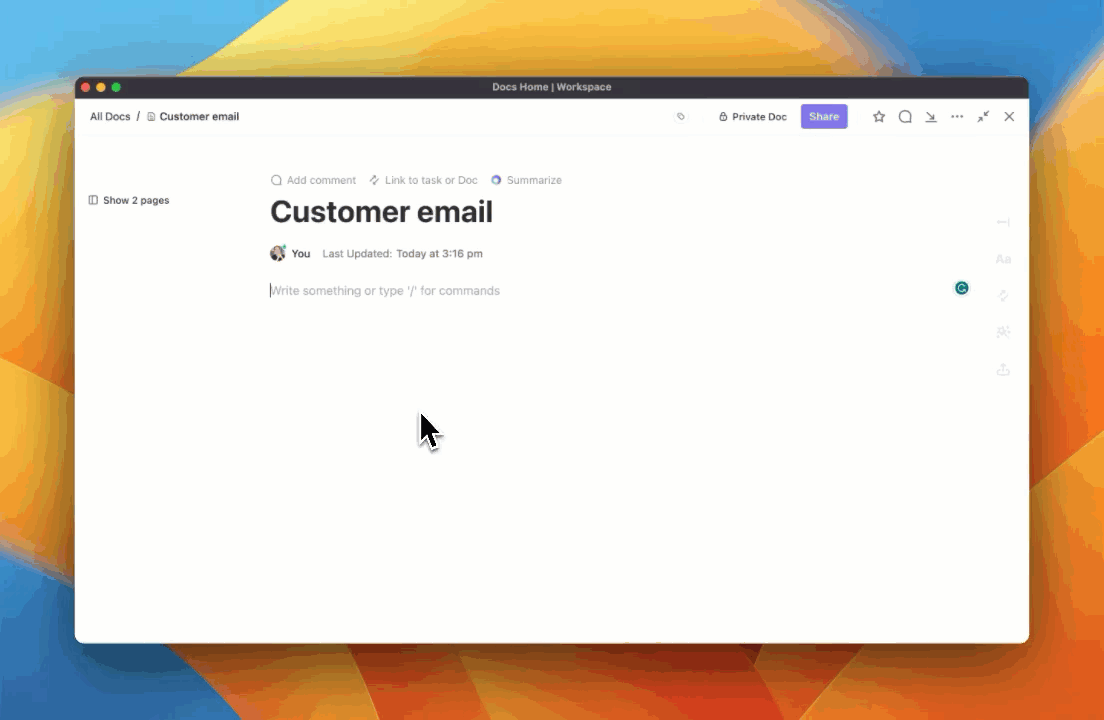An Ultimate Guide to Writing a Winning Job Proposal

Sorry, there were no results found for “”
Sorry, there were no results found for “”
Sorry, there were no results found for “”

On average, a new job opening receives 250 applications, which may seem insignificant at face value.
However, realizing that your chances of being selected are just 1 in 250 is sobering.
However, fear not, a killer job proposal could be a competitive differentiator that helps you stand out in the job market. That said, putting your thoughts on paper can be a daunting challenge. As if articulating your value proposition isn’t tricky enough, you must repackage it to make it attractive to the hiring manager.
At the same time, we’ve all had moments when the impostor syndrome kicks in and leaves us doubting ourselves.
While it may be a task and the stakes high, writing a job proposal does not have to be overwhelming. Let us demonstrate the art and science of writing a job proposal that commands attention, sparks curiosity, and lands you your dream job!
A job proposal is a formal document that pitches your candidature for a job. It typically spans three to six pages and highlights your qualifications, expertise, and proposed action for a specific role or project. Any job proposal aims to convince the hiring manager that you are an ideal candidate.
ClickUp’s Job Proposal Template is the perfect way to get started in seconds—get a ready-made document and customize it according to your needs.
A proposal letter is often written after you’ve made initial contact with the organization or when you understand their expectations, strengths, and weaknesses.
As such, some common scenarios where job proposals come into play include:
B2B Businesses may also utilize job proposals to expand their client base. Similarly, government agencies may float contracting tenders or Requests for Proposal (RFPs), in which organizations respond with a work proposal.
However, we’ll focus on job seekers seeking part-time or full-time jobs.
We will work with this narrower understanding of a job proposal—a persuasive pitch for a potential client or employer outlining why you’re the best candidate for a new position.
Now that we understand a job proposal, its anatomy, and when to use it, let’s talk about it. A well-crafted proposal letter typically contains:
Your Unique Selling Proposition (USP) demonstrates what makes you a good fit for the job.
Step into the hiring manager’s shoes to understand the company’s requirements and priorities. Use this perspective to craft a USP that blends your skills, experiences, expertise, and qualities. The alignment of your offerings with hiring requirements will make you the best candidate for the new position.
The problem statement in a project proposal identifies specific issues and challenges related to the project, and this logic applies to job proposals. It explains the current pain points or obstacles that are in the way of goal attainment. This demonstrates your understanding of the client’s needs, priorities, and challenges.
It also offers a taste of your domain expertise and research capabilities as you discuss market conditions, customer behavior and preferences, and competitor analysis.
Once you’ve built the context by elaborating on the problem statement, you can segue into the proposed solution.
Here’s where you pitch possible solutions that go beyond conventional approaches. Think of something original, effective, and impactful to display your commitment to delivering value.
Recommending creative and cutting-edge strategies to business challenges will help you stand out among the applicants. It illustrates your ability to think outside the box, apply skill sets or methodologies, leverage technology, adapt to changes, and consider various scenarios in the decision-making process.
Follow up on the possible solutions with a list of potential risks.
Identify various parameters that could impact solution implementation. You can then recommend risk mitigation and containment strategies.
Visualize risk as a multi-faceted entity by factoring in variables like resource constraints, technical difficulty, external dependencies, and unforeseen setbacks. Your ability to anticipate and address risks displays your foresight and management abilities.
A prospective employer would naturally feel more confident and reassured upon witnessing such a hands-on approach to navigating challenges.
Every business objective can be translated into Specific, Measurable, Achievable, Relevant, and Time-Bound (SMART) goals.
Convert the employer’s requirements, priorities, and preferences into SMART goals and align your deliverables accordingly. By defining SMART outcomes through performance metrics or key performance indicators (KPIs), you offer clear benchmarks for tracking performance, measuring progress, and quantifying value delivery.
This brings you and the prospective employer on the same page about what to expect from your professional association.
Zoom out from the project-specific details to share your track record of success, professional accomplishments, and relevant achievements. Also, share additional information about your professional goals, past experiences, and career trajectory that have shaped your skills or expertise.
The best way to present such information would be through case studies or customer testimonials. Such concrete examples are a testament to your capability to deliver results.
In this section of your job proposal, you can share relevant details about your values, principles, and work habits that guide your approach to conducting work.
Such information helps businesses evaluate whether you are a good culture fit. Emphasize qualities of collaborative working, team spirit, responsibility, accountability, and diligence to inspire trust and credibility.
A call to action is a clear directive on what to do next. Start by reinforcing your interest in the new position. Then, encourage further engagement. It may include scheduling a meeting, discussing project-related details, signing the contract, or commencing onboarding.
Such actionable closing catalyzes the decision-making process, demonstrating your proactiveness in securing opportunities and guiding clients toward a positive outcome.
We’ve got the skeleton ready. So, how about we flesh it out and get to the writing?
Here’s a step-by-step guide on how to write a holistic and complete proposal:

This foundational step can make or break your job proposal.
You must be confident that you are a good fit for the job; only then will you be able to convince the hiring managers.
So, start by carefully reviewing the detailed job description. Note the qualifications, expertise, expectations, and key deliverables attached to the specific requirement.
Compare these to your skills and qualifications. Highlight areas where the demand-supply match and identify gaps. You may also seek additional details or clarification that helps build a stronger case to your advantage.
Once satisfied that you possess the skills and expertise to apply for the job, start researching the company and the industry. Familiarize yourself with the company’s business models, mission and vision, industry trends, and competitors.
Keep up with recent developments, projects, or initiatives that will influence this new position. Such thorough research offers insights into the company’s goals, challenges, and preferences, allowing you to tailor the job proposal accordingly.
For instance, if the company commits to the principles of Diversity, Equity, and Inclusion (DEI), then diversity hires can highlight this in addition to their skills and competencies to improve their chances of selection.
Now that you’ve completed the groundwork, it is time to kickstart the writing part.
Start by creating an outline for your job proposal. It will help you organize your thoughts and present your candidature logically and persuasively.
Typically, you can divide your job proposal into three parts — the problem, the solution, and what makes you the best pick. Highlight the essential parts that you will cover in each section. Consider using an interview template to guide your outline and ensure you don’t forget crucial information.
As they say, first impressions matter. So, make a compelling one with an engaging introduction.
The best way to do it would be to treat it as an elevator pitch. Cut through the fluff and start with an opening statement that captures the hiring manager’s attention. Display your understanding of the job requirements and follow it up with a broad overview of your USP.
Use concise and persuasive language and use a positive tone. Tailor the communication to grab the reader’s interest and leave enough breadcrumbs to encourage them to continue reading.
With the introduction out of the way, back up your claims by demonstrating your skill and expertise in the area.
Set the context with an executive project summary. Share your insights on any background information, industry trends, and specific challenges that can influence project outcomes. This shows that you understand the client’s needs and priorities.
Then, weave in your skills, experience, achievements, and other credentials to persuade hiring managers that you are the best choice for the job. Pluck concrete examples, case studies, and testimonials that directly align with the project requirements to display your capabilities and past successes.
Doing so will position you as a trusted and reliable subject matter expert who can handle the project effectively.
Build on the foundations of the problem statement to pitch potential solutions. This will act as a platform to display your problem-solving abilities, creativity, and adaptability.
Present a comprehensive solution encompassing the project scope, proposed approach, methodology, and strategies for working on the project. Break them down into manageable phases or tasks for large or complex projects.
Outline actionable steps that bring the company closer to the desired outcomes, and explain the unique value you bring to the table throughout this journey.
You may share additional details such as the anticipated delivery timelines, work breakdown structure (WBS), project deliverables, and milestones. While doing so, share any constraints or dependencies that may influence the projected schedule.
Offer a breakdown of resources, such as budget, tools, technologies, or skills required for successful project completion. This grants an overview of your resource management capabilities while giving a glimpse of risk mitigation and planning.
Be as detailed as possible if you present an itemized cost for the proposed solution or define the tech stack. This realistic estimate of the required resources and your plan for resource allocation must align with the company goals.
For example, you may prioritize cost-saving and frugal fund management for startups. On the other hand, for enterprise projects where the outcome is synonymous with the brand, the quality of deliverables would be your primary focus. These changing priorities will impact your resource utilization patterns. Customize your proposal accordingly.
Conclude with a compelling call to action to encourage recruiters to take the next steps of hiring you for the new position. Reiterate the key takeaways of your proposal and express enthusiasm for the possibility of working together.
Encourage the company to contact you for clarification or further discussions. Share your contact details, such as your email, mobile, Skype ID, website, etc., to make yourself accessible.
Append the appropriate resources, supporting material, or documentation as an annexure to your proposal. This can contain your resume, portfolio, references, testimonials, case study, sample plan, etc. Ensure these annexures are well-organized, easy to access, and relevant to your proposal.

Finally, review your proposal to ensure it is professional, accurate, precise, and error-free. Evaluate the proposal carefully to cross-verify details and confirm that you’ve covered everything.
While doing so, also format it for enhanced readability and scanability. Using bullet points, bold text, etc., allows you to guide attention to specific parts of your work proposal.
You may use AI writing tools to proofread the proposal for any spelling, grammar, or formatting errors and to maintain consistency in tone and style. At the same time, seek feedback from colleagues or mentors for fresh and diverse perspectives. Incorporate their suggestions and make necessary changes to strengthen your proposal before submission.
Click on the submit button, and you’re done!
Use recruitment tools to track the status of your proposal and follow up with the employer to inquire about their decision. Maintain transparent communication and professionalism throughout the post-submission and follow-up process, and be prepared to provide additional information or clarification.
Even after the submission stage, displaying high engagement indicates proactiveness and commitment to excellence.
Now that you understand how to write a job proposal, it is time to hone this skill further.
Here are a few tips and tricks that will push your proposal into the spotlight:
To craft a compelling job proposal, you must use word processing software, a collaboration platform, a grammar and writing assistance tool, design solutions, etc.
Alternatively, you can swap them out for a single solution—ClickUp.
ClickUp is the one app that replaces all apps. We have seen great success when businesses have used ClickUp for Human Resources, whether managing end-to-end recruitment or onboarding new hires. As such, it should come as no surprise that you can also use it to write a job proposal.
Here are some features that can help:

ClickUp Docs is a centralized platform for storing, managing, and organizing all your documents, including job proposals. Use it to create a new document directly on ClickUp or import an existing one.
ClickUp Docs boasts a powerful word processor that allows you to create rich, value-loaded proposals while maintaining visual clarity. Whether formatting text or embedding multimedia content, everything is easier on ClickUp Docs. Plus, you can use the live collaboration feature to involve your colleagues or mentors in refining the proposal.

ClickUp Whiteboards is an excellent tool that you can use to write your job proposal. For instance, you can use it to conduct a SWOT analysis for the target company and plug your skill set and expertise into the gaps. You may also leverage it to brainstorm ideas, prepare an outline, hypothesize solutions, or document critical highlights of your proposal.
Once you have this idea, converting your thoughts or solutions into visual representations or storyboards to improve your proposal is easier. The rich media or narrative enhances the value of the proposal.

ClickUp Brain is a powerful writing assistant and knowledge manager. Use it to:
From initial idea generation to final adjustments, ClickUp Brain can streamline the entire proposal writing process!
ClickUp hosts a rich library of customizable templates for different documents for various use cases. Explore the job proposal template on ClickUp and configure it per the job requirement to save time and effort. Not just proposals, ClickUp also has several checklists that help you stay on track with your proposal writing.

ClickUp integrates with other tools and applications. For example, you can integrate ClickUp with Grammarly to optimize the writing quality. Similarly, it integrates with popular email service providers, allowing you to forward the proposal in just a click!
With the above features, you can be sure of securing a yes on your proposal.
Sign up for free with ClickUp today.
Your proposal’s format may vary depending on the job openings, specific requirements, and the recipient’s preferences.
That said, a typical proposal format should cover:
A job proposal includes:
The four Cs of a job proposal are:
No. A cover letter is a brief introduction of the candidate and is typically submitted along with the resume in response to job openings. On the other hand, a job proposal is a detailed document specific to a new position or a project. It aligns the qualifications, services, solutions, experience, etc., with the job requirements.
Bonus: Google Docs Cover Letter Templates!
No. A resume is a profile of your education, work experience, skills, accomplishments, etc. It is often submitted in response to job openings. A job proposal is a more refined resume since it closely matches the job requirement. It is an action item demonstrating how you apply your skills, knowledge, or services to address specific project challenges or problems.
A job proposal is typically three to six pages long.
© 2025 ClickUp